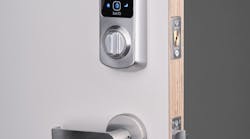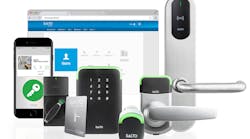As smart locks continue to proliferate in both professional and private spaces, questions often arise about which smart locks can withstand extreme precipitation, heat or cold. After all, a smart lock is an important investment and property owners want to be sure locking hardware will last as long as possible. But like the fine print on a credit card statement, finding this information can require a bit of hunting and unraveling. Here, we point security pros toward some ratings and resources to help them zero in on smart locks designed to handle any application and climate.
ANSI Ratings: Understanding Lock Durability
A good place to start is understanding American National Standards Institute/Builders Hardware Manufacturers Association( ANSI/BHMA) ratings, which are an indication of a lock’s quality. Specifically, this grading system was developed to measure the strength and durability of a lock.
- Grade 3: This basic door hardware is often found on residential properties. While the least expensive, locks in this grade are not highly durable. Grade 3 locks must handle 200,000 cycles or 200,000 lock/unlock operations.
- Grade 2: These locks undergo more testing and offer a higher level of security. Grade 2 locks are usually sufficient for “light commercial” applications and exceed the requirements for residential properties. These locks must handle 400,000 cycles.
- Grade 1: This is the highest rating. These locks are typically used for commercial security, but there are some current trends for residential use, particularly with electronic locks. They are typically the most expensive and you won’t find as many style or finish options. These locks must withstand 800,000 cycles.
While ANSI ratings are one good indicator of a lock’s quality, RemoteLock’s Director of Hardware Partnerships Brian Parrish offers a note of caution. Some import manufacturing companies sell smart locks at an opening price-point that claim to meet these ratings, but actually don’t, Parrish warns. He recommends reviewing a free directory created by the BHMA. “This lets you know which smart locks are truly certified,” says Parrish. The certification is based upon a series of tests verified by independent, third-party laboratories that determine if the products meet the cycle, operational, strength, security and finish performance requirements. And the products must undergo recertification periodically to ensure they’re still up to par.
IP Ratings: Understanding Weather Resistance
Next up, look at a smart lock’s IP (Ingress Protection Rating or International Protection) rating. An IP rating defines the levels of sealing effectiveness of electrical enclosures against foreign bodies like water or dirt. Although these ratings were initially developed as a way to classify enclosures, they provide dealers with a convenient, practical way to compare levels of sealing. Plus, these ratings promote uniformity when describing the level of protection, as well as the tests used to prove various degrees of protection.
For those who want to geek out on the nitty-gritty, a complete description of the IP ratings and associated tests from the International Electrotechnical Commission (IEC) is available in IEC Publication 529. But even a basic understanding of the ratings helps empower locksmiths to guide their customers in purchase decisions.
First, look at the desired smart lock’s data or product sheet, often found on the manufacturer’s website. Included in technical specifications is usually a section called “Certifications and Testing.” ANSI ratings are typically found here, as well as IP ratings. IP ratings consist of two digits that follow the letters “IP.”
The first digit represents the degree of protection against solid foreign bodies.
Level 1: Protected against a solid object greater than 50mm, such as a hand
Level 2: Protected against a solid object greater than 12.5mm, such as a finger
Level 3: Protected against a solid object greater than 2.5 mm, such as a screwdriver
Level 4: Protected against a solid object greater than 1mm, such as a wire
Level 5: Dust protected: Limited ingress of dust permitted; will not interfere with operation of equipment
Level 6: Dust tight: No ingress of dust
The second number describes the degree of protection against water.
Level 1: Protected against vertically falling drops of water
Level 2: Protected against vertically falling drops of water when tilted up to 15 degrees from the vertical
Level 3: Protected against sprays of water up to 60 degrees from the vertical
Level 4: Protected against water splashed from all directions
Level 5: Protected against jets of water
Level 6: Protected against powerful water jets
Level 7: Can withstand immersion of up to 1m
Level 8: Can withstand immersion beyond 1m
So, for a smart deadbolt with an IP rating of IP54, the “5” describes the level of protection from solid objects and the “4” describes the level of protection from liquids. From this, a security pro can determine that the deadbolt is designed and built for protection against dust with no harmful deposits and can withstand low-pressure jets of water from all directions.
Reviewing Hot & Cold Operating Conditions
No sleuthing is usually needed to find the temperatures a smart lock is designed to withstand. Look at the product or data sheet once again under “Environmental Operating Conditions,” or a similar section about operating temperatures to see the low and high temperatures the lock can tolerate.
Once locksmiths and their customers understand these ratings and how they’re achieved, as well as the operating temperatures, they’re on their way to identifying a smart lock that lasts and does its job to protect their customers’ properties.
Not All Smart Locks Are Created Equal
After reviewing these ratings, some may be tempted to just purchase a smart lock with the highest ANSI and IP ratings. RemoteLock’s Chief Product Officer Daniel Bailin suggests the lure of taking a blanket approach is not always the most budget-friendly for customers and could prevent security pros from winning a project. “ANSI-rated and IP-rated locks typically cost more, and hence it’s important to choose a lock that meets the needs of the application without going beyond it,” he says.
Bailin offers the example of a multifamily building or condominium complex. “You’ll run into applications where the smart lock is exposed on both sides like a gate to a swimming pool,” Bailin explains. “Here, a smart lock with higher ANSI and IP ratings is necessary, as the hardware is constantly exposed to the elements. And you may even consider a smart lock model that comes with a cover to provide additional protection. But an interior hallway in the complex? Not so much.”
Parrish echoes this sentiment, offering that the broader a security pro’s depth of knowledge on the landscape of locks, the more business they can close. “When you cultivate an extensive knowledge base, you’re not tempted to standardize on one lock or brand. Instead, you can identify the right locking hardware for each application.” This proves critical for bigger jobs on properties with different door types, and varying environmental conditions and traffic levels.
The Software Behind the Smart Lock
No matter the product selection, both Bailin and Parrish stress that the software behind the smart lock is vitally important . Beyond allowing for remote management of the smart lock, the software should accommodate different door types at the same property, or across a portfolio on a single platform versus convoluting operations with disparate access solutions.
Additionally, the software should work with a wide variety of smart lock brands and connection methods (Wi-Fi, Bluetooth, Z-Wave), ensuring that the most cost-effective device can be used on each door in a property.
Lastly, Bailin and Parrish recommend looking for a software provider who embraces design with an open API to ensure inevitable future integrations will work seamlessly without ripping and replacing hardware.





